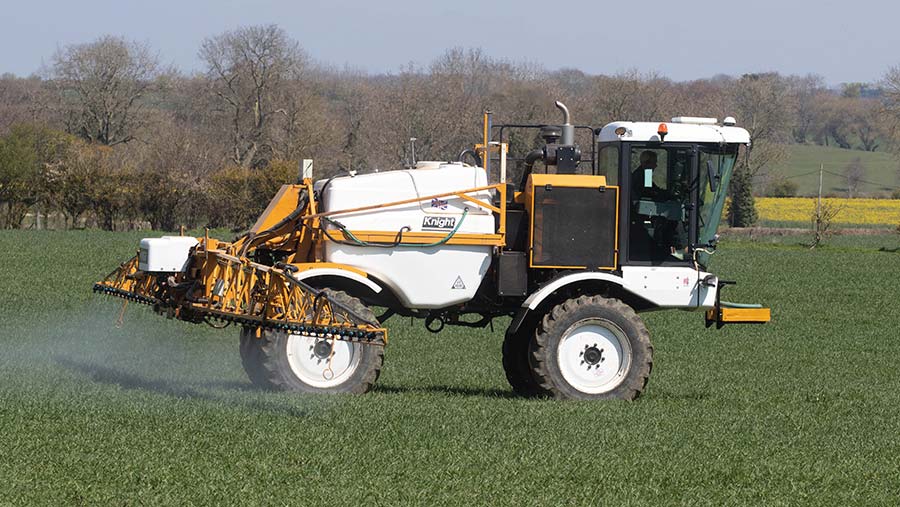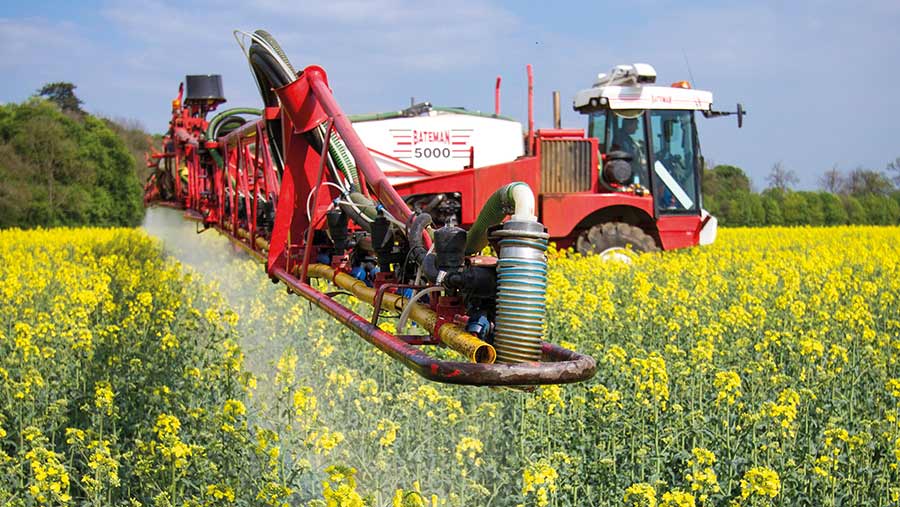Crop Watch: T1 plans bolstered to tackle rising septoria risk

Hopes are growing for a spell of drier weather to help ease the septoria epidemic being seen in wheat crops. With T1s coming up, some fungicide programes are being bolstered to keep on top of this disease.
In contrast, yellow rust pressure remains low, but that could soon rise as temperatures warm up in the coming days.
East
Marion Self
AICC/Prime Agriculture (Suffolk)
Winter cereals have moved into the construction phase; crops in high fertility (especially after muck and sludge applications) are well tillered and relatively thick.
Large, fast growing canopies need containing with plant growth regulators (PGRs), programmed to give consistent shortening during this period.
See also: Wildfarmed: How regen farmers can benefit from premium
T1 fungicide applications should be timed during the emergence of final leaf three.
Early to mid-September-drilled crops are now at/beyond this stage while late September and October-drilled crops are now reaching this critical timing.
T1s should be robust, reflecting high septoria risk and significant, “aggressive” tritici populations within the crop.
It is worth noting that some of the “cleaner” varieties for septoria are also carrying this disease on final leaf four.
Wise investment now will help reduce the base of the epidemic from which later (more yield-building) leaves can be infected. However, even with robust programmes in place, we hope for drier weather to help hold the epidemic.
On early crops, if the T1 application is late, more curative septoria activity will be required by using a high dose of the most appropriate actives.
Until now, yellow rust pressure has been relatively low, but this is expected to escalate as temperatures warm.
On rust-susceptible varieties protection/prevention is best; choose a programme that keeps it out.
On some varieties, more stem base browning is being seen this season; again tailor your programme according to the disease profile and risk.
Barley
Winter barley will move quickly through its growth stages now, so keep planned inputs in step with development and ahead of cutoff timings for crop safety.
Spring cereals have established. As they reach early stem extension they will require nutrition, fungicides, herbicides and PGRs as appropriate.
Wetter and now milder conditions have encouraged a further flush of broad-leaved weeds in many crops. Where control of these is outstanding, check the label for the latest safe timing of individual products, as they do vary.
Winter beans are a mixed bag in terms of yield potential, and forward, thick crops are now budding.
Some crops, often those more forward or those backward and stressed, have relatively high levels of chocolate spot, cercospora and sometimes downy mildew for the time of year.
Good plant health is critical to help the crop fight disease, especially as established infections can be difficult and expensive to control with chemistry.
Crops would benefit from additional nutrition, such as manganese, magnesium etc, and those with early chocolate spot should be treated with tebuconazole.
West
Antony Wade
Hillhampton Technical Services (Heref/Shrops)
Oilseed rape crops are starting to flower and many had yellow bud/early flower sprays 10-14 days ago.
Where plant growth regulators were included, they have done a good job in controlling main raceme height and dominance. Mid-flower sprays to protect against sclerotinia infection will be timed in 7-10 days.
We only have protectant activity from fungicides and the devastating impact a serious sclerotinia infection can have, although current risk prediction is fairly low for my region, but this could change if temperatures rise.
Winter barley benefits more than other cereals from early inputs like the T0, but these have been difficult to apply with the lack of spraying weather in March.
Many T0 plans have had to be revised to make them T1, although I have been surprised that barley crops have been slow to take off.
Disease levels in the wet weather have been building, with rhynchosporium and net blotch easy to find, so Ascra (bixafen + fluopyram + prothioconazole) has been the upgrade generally.
In contrast, I have some early drilled wheat crops where final leaf three is starting to emerge, ahead of the normal rule of thumb of T1s around St George’s Day.
Absent yellow rust
Yellow rust so far has been noticeable by its absence, although I don’t have any of the high-risk yellow rust varieties – even on the odd field of Zyatt it is absent.
Where I have been able to get a T0 on, this has been a laminarin septoria elicitor as this is our main focus. Due to weather this has included contact grassweed herbicides.
T1 fungicides have, by necessity due to predicted “shortages” of the key fungicides, been on farm in many cases a number of weeks.
But with the numerous rain splash events, and with septoria lesions already covering the tips of leaves five and six even on more resistant varieties such as Extase and Palladium, plans are changing.
I am starting to supplement robust SDHI/azole co-form rates with the multisite folpet to bolster septoria control.
Winter oats are, as usual, looking well, but are only slowly moving into stem extension. Mildew levels have been surprisingly low through the winter and early spring. Stronger crops will be getting a plant growth regulator.
For my oats I exclusively use Canopy (mepiquat + prohexadione), as it seems to be the kindest on the crop. Low rates of fungicide will be used at this stage.
North
Mary Munro
AICC/Strutt and Parker (Perthshire)
Spring 2023 is a very different beast to the previous two years, which were bone-dry from March till June. We are a good week later than 2022 with sowing, and there are still areas that are too wet to work.
A lot of progress has been made in the past week and, despite the odd sleety shower, the ground is gradually drying out. The earliest spring barleys and beans are through the ground now.
The winter crops have really started to shift, however, and oilseed rape is just coming into flower.
I have not sprayed for light leaf spot at all for a few seasons now and a mid-flowering dose of Aviator (bixafen + prothioconazole) is all the fungicide I plan to apply.
Winter barley is also about to do its annual growth spurt and T1s of a 0.5-0.6 litres/ha shot of Siltra (bixafen + prothioconazole), with manganese and plant growth regulator, have just gone on this week.
There is a lot of debate about the best option for ramularia control at T2. I am inclined to go with Ascra, but will see what the weather throws at us before committing myself.
Product problems
Product availability in general is becoming a real pain, and the whole point of independent agronomy is the ability to pick the product and rate we feel most appropriate to each situation.
Having to order products a long time in advance is not always ideal, but having been in this game for a fair few years, it is always possible to come up with a suitable solution.
Wheat crops are looking well, with the most forward ones now into stem extension and T0s applied. There is more of a range in growth stages and the backward ones will get T0 this week.
I like to split the PGR and get some on now, with the balance at T1.
The choice and rate of fungicide varies with variety – most of our growers are not working with varieties that are prone to mildew or yellow rust, but there are a couple of exceptions.
For the most part it is based on tebuconazole with a strobilurin or mildewicide as required.
These crops will get manganese at T0 as well – many of my growers are farming on limestone ridges and the pHs tend to be on the high side.

© GNP
South
Jamie Swift
Procam (East Sussex)
Timing is a crucial factor for successful spring fungicide programmes, but Mother Nature has somewhat rained on our parade so far, creating a tricky starting point to the season.
Although the interval has been narrowing all the time, I have for as long as possible been encouraging people to persevere with T0s, as it’s not just about fungicides, but growth regulation has been high priority – with crops being extremely lush, having had good nitrogen uptake.
Where T0s were delayed or even abandoned, disease pressure is mounting amongst the large canopies, with high levels of septoria being noted even on the more robust varieties.
Visible yellow rust levels are low, but the T0 success needs to be factored into T1 decisions, as the short lifecycle of this disease means it can soon explode, especially if the catchy weather continues and the next application is delayed.
Given the high septoria pressure, I will be ensuring a multisite is always used at T1 to further bolster septoria control and support the core chemistry.
This gives a notable improvement in the programme’s performance and the progression of disease up the canopy, but also contributes to the ever-important matter of resistance management.
Oilseed rape crops are now beginning to flower, making the pollen beetle a friend rather than foe.
Their presence in the more backwards crops still requires monitoring, however, and I will have no choice but to treat if we reach threshold, as these crops don’t need any more setbacks.
Sclerotinia spray
Good moisture levels mean that sclerotinia infection in oilseed rape has an even greater potential than in the past few years, so I’ll be keeping a close eye on AHDB’s forecasting tool in the coming weeks, bearing in mind that the fungicides we have available are only preventative and need applying ahead of infection.
Maize is a valuable break crop, providing both on-farm feed as well as bringing diversity to the rotation, which is key for weed management.
As drilling begins, it’s important to remember that good seed-bed preparation is key to a well-established crop, as well as the effectiveness of herbicides.
Maize is highly sensitive to early weed competition, so good seed-beds are needed to ensure herbicides have the best chance of success, especially where grassweeds are being targeted.
Other spring crops are emerging nicely, having been drilled into good moisture levels. This, coupled with sporadic sunny spells, means these crops have good potential and I am quietly optimistic about their potential.
With that in mind, a close eye on disease management will be needed as it can’t be assumed these short growing season crops will escape.

